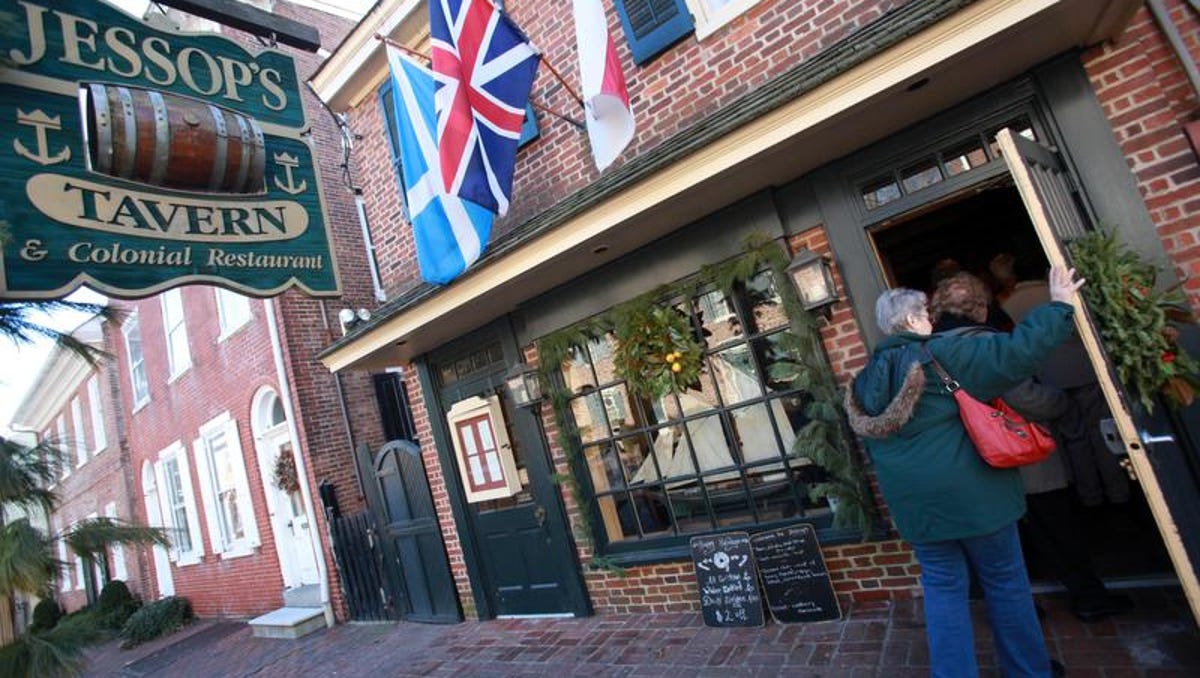Delaware
Jessop’s Tavern in Old New Castle gets $50,000 grant for updates

Deer Park Tavern named one of USA TODAY’s best bars of 2024: Video
Take a look inside Deer Park Tavern in Newark, Delaware, named one of USA TODAY’s Bars of the Year for 2024.
Jessop’s Tavern in Old New Castle is one of 50 small U.S. restaurants that will receive a $50,000 grant from a historic preservation organization to upgrade, bolster, and grow its business.
The money given to the colonial American tavern, which has roots tracing back 350 years, comes from a four-year-old program from American Express and the National Trust for Historic Preservation’s “Backing Historic Small Restaurants.”
It was started in 2021 to help culturally significant restaurants during the pandemic. The program has aided nearly 125 historic small restaurants in every U.S. state, Washington D.C.., and Puerto Rico.
The restaurant management software company Resy also is offering each historic restaurant complimentary use of its program for one year to help streamline costs and boost restaurant operations.
The National Trust for Historic Preservation selected this year’s grantees from a group of restaurants that operate in historic buildings or neighborhoods and provide cultural significance to their communities through their history, cuisine, and locations.
Many of the 2024 grant recipients include family-owned establishments or those operating for generations.
Jessop’s Tavern at 114 Delaware St. in the historic section of New Castle has been operated by the Day family since November 1996. The colonial tavern is located in a structure that was built in 1674 and predates the end of the Revolutionary War by more than 100 years.
The name Jessop’s comes from Abraham Jessop, a coppersmith who began living in the building in 1724 and operated his barrel-making business there.
It has housed various businesses through the years including the Captain’s Log restaurant in the 1950s and The Green Frog Tavern in the 1970s.
Jessop’s serves American foods with English, Dutch, Belgian, and Swedish influences such as Dutch pot roast, shepherd’s pie, roast duck and Dutch apple cakes.
What do you think? These are the Top 100 restaurants in Delaware, Yelp says, and No. 1 is a coffee shop
Delaware landmark: Owners of a USA TODAY Bar of the Year purchase landmark Stanley’s Tavern
It is well-known for its focus on Belgian beers, with more than 300 bottles and 20 drafts dedicated to Belgian brands. Don’t be surprised to see someone in a tricorn hat. The staff has been known to wear colonial-style garb.
Here is the complete list of restaurants that received grants.
Visit savingplaces.org/historicrestaurants for more nformation.
Patricia Talorico writes about food and restaurants. You can find her on Instagram, X and Facebook. Email ptalorico@delawareonline.com. Sign up for her Delaware Eats newsletter.

Delaware
Why Amazon is doubling down on robots at its massive Delaware fulfillment center

Working side by side
Autonomous motorized robots known as drivers look like solid plastic pallets low to the ground. They wheel themselves over QR codes on the floor and are controlled by computer algorithms.
On its top, one of these robots can carry a shelving unit in the picking section or, in the sortation section, a single cardboard package that’s nearly ready for shipping.
Years ago, workers would walk miles each day to retrieve products themselves. But now, when attached to drivers, the shelving units move themselves across the fulfillment center’s cement floor and bring products to employees for packing.
There’s a single robotic arm attached to a platform used in the sortation section that works with the drivers to move packages along.
The large, robotic arm sweeps across a conveyor belt to pick up and sort packages that already have shipping labels on them. It uses suction cups to pick up the packages, uses a camera to scan the labels, and sets the packages on the drivers that wheel themselves to the right chute, where packages keep traveling to the next processing area.
There are still manual package sortation stations where workers pick up boxes from a conveyor belt and place them on those robotic drivers.
Those stations are usually reserved for high-demand periods like busy shopping seasons; the stations are only opened when the robotic arm section hits max capacity. On average, about 80% of packages are sorted by autonomous robots.
There are about two dozen of those robotic arms attached to the platforms in the sortation section working now. They can process 150% more packages than humans, in part because they don’t take breaks and run 24 hours a day.
The average package at the facility is 25 pounds or lighter. The robotic arms can lift up to 50 pounds if the suction cups have a good grasp.
“Instead of the associate being focused on the physical lifting, the role has now transferred to, ‘How do I keep the robots on the floor running?’” Jones said. “The automation allows for the associate to focus on quality inspection.”
The company is investing in new robotic arms on a different floor of the facility as its expansion plan.
The average nationwide hourly wage at a customer fulfillment center and operations job is $22 an hour. When benefits are included, the company estimates the value is $29 an hour.
Amazon declined to share how much the robots cost for initial purchase and maintenance. But through generative artificial intelligence the company is “optimizing our supply chain planning, forecasting and delivery routing as well as creating new capabilities in robotics and automation,” the company said.
Delaware
School is closing for the summer. Is your child ready to stay home alone?
How to prep your yard for the summer
Get your yard ready for some summer fun!
Problem Solved
Memorial Day has passed, and the end of the school year is right around the corner.
Kids will be home for the summer, leaving parents with the question: Can they be home alone?
It’s tricky for any parent, but here’s some help to make a decision.
How old does a child have to be to stay home alone in Delaware?
There is no law in Delaware regulating an appropriate age for a child to be left home alone, according to Delaware’s Department of Services for Children, Youth and Their Families.
When can a child stay home alone?
The American Academy of Pediatrics’ website says most child experts agree that around 11 or 12 is an appropriate age for a child to stay home alone. Here are some things to consider when making the decision.
- Maturity level and safety: Is your child mature enough to handle being home alone and able to handle themselves if something happens, like a power outage or an emergency, like a fire or gas leak?
- Trust level: Do you trust your children to think before they act? This is important for teens who may be tempted to experiment with illegal activities. Think about how your child responds to peer pressure. Also, can you trust your child to follow the rules of the house?
- Common sense: Will your child make sound judgments? If your child grabbed the milk and it smelled sour or was curdled, would they throw it out or drink it?
- Keeping busy: Outside of video games and television, can your child stay busy with other hobbies or interests while you are out?
- Comfort level: How do you feel about leaving your child home alone? Talk to your child about the possibility and realize you know your child the best.
What to do before a child stays home alone
Once you decide to let your child stay home alone, here are ways to prepare.
Emergency plan
- Make a list of cellphone numbers, workplace numbers and how to reach family members and your pediatrician. Post them in a visible location.
- Have a first-aid kit available for minor injuries and teach your child how to use all of the supplies in the kit
- Show your child where the batteries, flashlights or other emergency supplies are in case something happens.
- If you have an alarm system, ensure your child knows how to turn it on and off.
- Make sure your child knows how and when to call 911.
- Go over the emergency exit plan. Ensure your child knows what to do if there is a fire or gas leak.
Establish the ground rules
- Are friends allowed in the house while the child is home alone?
- Is the child allowed to cook and what foods are off-limits?
- Can the child answer the phone or the door while you are out?
- What should the child do with your dog or cat while you are gone?
Delaware
Delaware Provides Middle-Class Americans Plenty of Average-Priced Home Options Right Now

While most Americans fear that the dream of owning a home is all but over, Delaware offers new hope, especially for middle-class homebuyers.
With its mix of coastal charm, tax advantages, and manageable home prices, the First State is quietly becoming a haven for those seeking to buy without breaking the bank.
And so the American dream lives on!
Delaware’s home prices are well within reach for most
Middle-class Americans in Delaware bring in a median household income of $79,325, or roughly $6,610 per month, according to SmartAsset analysis of 2023 income data from the U.S. Census Bureau.
With a comfortable mortgage budget of $1,983 per month—based on the widely recommended 30% income threshold—buyers in this bracket can afford a home priced around $396,422.
The good news? Delaware’s median home price is $369,900, according to the latest Realtor.com® data. That puts average-priced homes within reach for many middle-class households, a rare feat in today’s market. The affordability alignment between income and housing costs positions Delaware as one of the few states where the numbers genuinely work for middle-income earners.
What’s more, Delaware’s low property taxes and absence of a sales tax further enhance affordability, stretching household budgets in ways that few other states can.
Coastal Living Without the Premium Price Tag
One of Delaware’s most compelling features is its access to the Atlantic coastline—without the high price premiums typically associated with beach towns.
Places like Lewes, Rehoboth Beach, and Bethany Beach offer picturesque living that’s far more attainable than similar locales in neighboring states. However, the beach life isn’t as attainable for the average working family in the state.
But if you look to inland towns like Milford and Seaford, you’ll find home prices well within a middle-class budget, offering a mix of new construction and well loved properties. While you may not get sunset views over the oceans, these towns have walkable downtowns, family-friendly amenities, and easy commutes to the ocean for a day away.
Moreover, the growing development in Kent and Sussex counties provides even more opportunities for affordable housing near nature trails, waterways, and recreational spots—all without the big-city price tags.
Retiree Appeal Is Boosting Infrastructure—And Opportunity
Delaware’s growing popularity among retirees has led to an unexpected benefit for middle-class buyers: enhanced infrastructure. As 55+ communities and age-friendly neighborhoods spring up, the surrounding areas are seeing upgrades in everything from healthcare to public transit to retail.
This rising tide of investment helps make smaller communities more livable for families and professionals alike. And with many retirees selling higher-priced homes in other states to downsize in Delaware, the housing turnover has created a steady stream of inventory that helps moderate price pressure.
As other markets overheat or freeze up entirely, Delaware strikes a rare balance—affordable, accessible, and increasingly appealing for middle-class Americans looking to make home ownership a reality.
Related Articles
-

 News1 week ago
News1 week agoMaps: 3.8-Magnitude Earthquake Strikes Southern California
-

 Culture1 week ago
Culture1 week agoDo You Know the English Novels That Inspired These Movies and TV Shows?
-

 Education1 week ago
Education1 week agoVideo: Columbia University President Is Booed at Commencement Ceremony
-

 Education1 week ago
Education1 week agoHow Usher Writes a Commencement Speech
-

 Politics1 week ago
Politics1 week agoTrump, alongside first lady, to sign bill criminalizing revenge porn and AI deepfakes
-

 World1 week ago
World1 week agoDigitisation fronts new Commission strategy to boost EU single market
-

 Politics1 week ago
Politics1 week agoExpert reveals how companies are rebranding 'toxic' DEI policies to skirt Trump-era bans: 'New wrapper'
-

 World1 week ago
World1 week agoEU reaches initial deal to lift economic sanctions on Syria: Reports




















